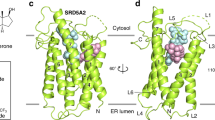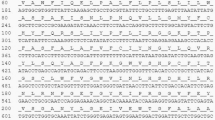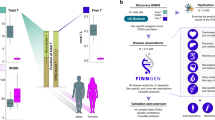Abstract
Androgens determine male secondary sexual characteristics and influence a variety of metabolic pathways. Circulating levels of androgens are highly heritable; however, the genes involved are largely unknown. The 5α-reductase enzymes types 1 and 2 responsible for converting testosterone to the more potent androgen dihydrotestosterone are encoded by the SRD5A1 and SRD5A2 genes, respectively. We performed indirect genetic association studies of SRD5A1 and SRD5A2 and the dihydrotestosterone/testosterone ratio that reflects the activity of 5α-reductase in 57 males with type 2 diabetes. We found evidence of significant association between a single nucleotide polymorphism in SRD5A1 and the dihydrotestosterone/testosterone ratio (median 0.10, interquartile range 0.08 vs. median 0.06, interquartile range 0.04, P=0.009). The polymorphism was not associated with any diabetic phenotypes. These results suggest that functional genetic variants might exist in or around SRD5A1 that affect the activity of the 5α-reductase enzyme type 1 and influence androgen levels.
Similar content being viewed by others
Log in or create a free account to read this content
Gain free access to this article, as well as selected content from this journal and more on nature.com
or
References
Ellis JA, Stebbing M, Harrap SB (1998) Genetic analysis of male pattern baldness and the 5α-reductase genes. J Invest Dermatol 110:849–853
Janne OA, Palvimo JJ, Kallio P, Mehto M (1993) Androgen receptor and mechanism of androgen action. Ann Med 25:83–89
Jenkins EP, Hseih CH, Milatovich A, Normington K, Berman DM, Francke U, Russell DW (1991) Characterisation and chromosomal mapping of a human steroid 5α-reductase gene and pseudogene and mapping of the mouse homologue. Genomics 11:1102–1112
Jenkins EP, Andersson S, Imperato-McGinley J, Wilson JD, Russell DW (1992) Genetic and pharmacological evidence for more than one human steroid 5α-reductase. J Clin Invest 89:293–300
Livingstone C, Collison M (2002) Sex steroids and insulin resistance. Clin Sci 102:151–166
MacIsaac R, Tsalamandris C, Panagiotopoulos S, Smith TJ, McNeil KJ, Jerums G (2004) Nonalbuminuric renal insufficiency in type 2 diabetes. Diabetes Care 27:195–200
Martin ER, Lai EH, Gilbert JR, Rogala AR, Afshari AJ, Riley J, Finch KL, Stevens JF, Livak KJ, Slotterbeck BD, Slifer SH, Warren LL, Conneally PM, Schmechel DE, Purvis I, Pericak-Vance MA, Roses AD, Vance JM (2000) SNPing away at complex diseases: analysis of single-nucleotide polymorphisms around APOE in Alzheimer disease. Am J Hum Genet 67:383–394
Meikle AW, Bishop DT, Stringham JD, West DW (1986) Quantitating genetic and non-genetic factors that determine plasma sex steroid variation in normal male twins. Metabolism 35:1090–1095
Meikle AW, Stringham JD, Bishop T, West DW (1988) Quantitating genetic and non-genetic factors influencing androgen production and clearance rates in men. J Clin Endocrinol Metab 67:104–109
Randall VA (1997) The role of androgens in the regulation of the human hair follicle. In: Azziz R, Nestler JE, Dewailly D (eds) Androgen excess disorders in women. Lippincott-Raven, Philadelphia, pp 115–129
Thigpen AE, Silver RI, Guileyardo JM, Casey ML, McConnell JD, Russell DW (1993) Tissue distribution and ontogeny of steroid 5α-reductase isozyme expression. J Clin Invest 92:903–910
Vanderschueren D, Vandenput L, Boonen S, Lindberg MK, Bouillon R, Ohlsson C (2004) Androgens and bone. Endocr Rev 25:389–425
Vermeulen A, Verdonck L, Kaufman JM (1999) A critical evaluation of simple methods for the estimation of free testosterone in serum. J Clin Endocrinol Metab 84:3666–3672
Wu FCW, von Eckardstein A (2003) Androgens and coronary artery disease. Endocr Rev 24:183–217
Acknowledgements
We thank Professor Jean Kaufman, Department of Endocrinology, University Hospital, Ghent, Belgium, for supplying the free testosterone calculator, and Dr. Katrina Scurrah, Department of Physiology, University of Melbourne, for statistical advice.
Author information
Authors and Affiliations
Corresponding author
Rights and permissions
About this article
Cite this article
Ellis, J.A., Panagiotopoulos, S., Akdeniz, A. et al. Androgenic correlates of genetic variation in the gene encoding 5α-reductase type 1. J Hum Genet 50, 534–537 (2005). https://doi.org/10.1007/s10038-005-0289-x
Received:
Accepted:
Published:
Issue date:
DOI: https://doi.org/10.1007/s10038-005-0289-x
Keywords
This article is cited by
-
Advances in Knowledge of Androgens: How Intentional and Accidental Neurosteroid Changes Inform Us of Their Action and Role
Current Sexual Health Reports (2020)
-
Analysis of the B cell receptor repertoire in six immune-mediated diseases
Nature (2019)
-
Ethanol withdrawal-induced dysregulation of neurosteroid levels in plasma, cortex, and hippocampus in genetic animal models of high and low withdrawal
Psychopharmacology (2017)
-
Null Mutation of 5α-Reductase Type I Gene Alters Ethanol Consumption Patterns in a Sex-Dependent Manner
Behavior Genetics (2015)
-
“Cold” X5 Hairlaser™ used to treat male androgenic alopecia and hair growth: an uncontrolled pilot study
BMC Research Notes (2014)



